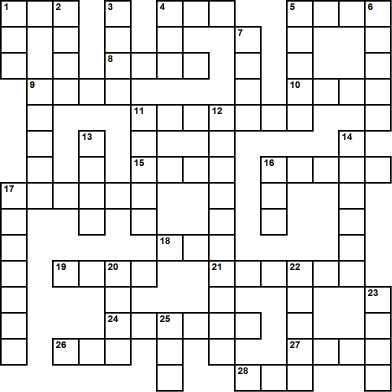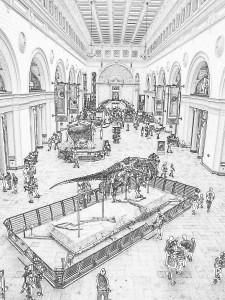Monthly Archives: March 2012
Crossword – Irregular Verbs 2 (Solution)
Crossword – Irregular Verbs 2
Here is another crossword with irregular verbs. I’ve given the present tense of the verb – you have to put the right form of the past tense or past perfect in the puzzle. Have fun!
Across
1. hit
4. light
5. blow
8. ride
9. see
10. lose
11. think
15. read
16. stand
17. become
18. is/am
19. sell
21. teach
24. forget
26. set
27. wake
28. win
Down
1. has/have
2. tear
3. wear
4. lead
5. build
6. write
7. hang
9. steal
11. throw
12. understand
13. swim
14. buy
16. sit
17. bring
20. leave
22. grow
23. fly
25. run
Idiom Focus: Animal Idioms 13
Every Saturday I’ll give you a couple of idioms to learn. An idiom is a saying or phrase whose meaning cannot be taken from the literal meanings of the words.
get off one’s high horse: to stop being arrogant, to begin to be humble and agreeable
Example:
Maybe more people would like Sam if he got off his high horse, instead of boasting about how much money he has.
go ape: to go crazy or act wildly with excitement; get agitated
Example:
The children went ape as soon as they reached the playground, and ran excitedly from one piece of equipment to the other.
Writing Assignment: At the Museum (Solution)
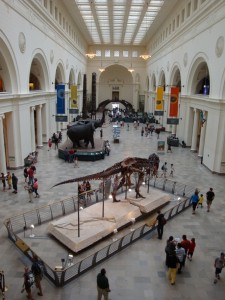
1. Where is this picture taken?
This picture is taken inside the great hall of a museum.
2. What do you see in the picture?
We see some displays, and people walking around.
3. How many displays are there in the great hall?
There are two displays visible in the great hall, a dinosaur skeleton, and an elephant diorama.
4. What type of museum do you think this is?
This museum is a natural history museum.
5. What other types of museums are there?
There are science museums, museums of art, music museums, cultural museums, lighthouse museums, living history museums, children’s museums (also called discovery museums or hands-on museums) and many other kinds.
6. What can you see at a museum?
At a museum you can see displays and exhibits.
7. What else might you see in a museum besides the exhibits?
You can also see models of things and stuffed animals, along with much more.
8. What kind of exhibits are in a museum only for a short time before they are sent to another museum?
Traveling exhibits are in a museum only for a short time, and then they are sent to another museum. It’s a way for museums to share their resources and allow many more people to enjoy the exhibits than would be possible if the exhibit stayed in only one place.
9. What kinds of people usually visit a museum?
Many people like to visit museums – school children, tourists, people who enjoy history, science, or culture.
10. What is a school trip to a museum called?
A school trip to a museum (or something similar) is called a field trip.
11. How can you get to the museum?
You can get to the museum by bus, train, taxi, car, or on foot.
12. What can you do with your car while you are at the museum?
If you drive your car, you can park your car in the parking lot. In some big cities, parking validation might be included in your admission.
13. What do you often need to get inside the museum?
To get inside the museum you usually need a ticket.
14. What kind of special deals are often available for admission?
There are often special deals on admission for school students, senior citizens, or groups of a minimum size. Sometimes museums will have free admission days, or discount days. Some museums have season passes which allow unlimited visits for the year. Some museums have reciprocal admission tickets, which will allow you to visit several museums in the city for one combined price.
15. If you leave the museum but want to come back the same day, how can you get back in?
If you want to leave the museum for some reason but are planning on coming back later that same day, you can have your hand stamped with a re-entry stamp.
16. How can you find your way around the museum?
You can find your way around the museum by using the museum map. You can also have a guide take you around the museum on a guided tour, or you can go on a self-guided tour.
17. What are the different parts of the museum called?
Off the great hall, or main hall, there are different wings of the museum.
18. Who works at a museum?
People who work at a museum would include the curator of the museum, the guides, the guards, the ticket takers, the people who run the museum shop, and the cafeteria workers.
19. Can you take pictures in a museum?
Some museums will let you take pictures, some will not. Some allow pictures, but prohibit flash photography.
20. What kinds of displays do they have at a children’s museum?
A children’s museum usually has many interactive, hands-on displays.
Paragraph: A Visit to the Museum
Chicago’s Museums
Chicago is home to a number of world-class museums. The most well-known of these are: the Field Museum of Natural History, the John G. Shedd Aquarium, the Adler Planetarium & Astronomy Museum, and the Museum of Science and Industry.
The Field Museum of Natural History
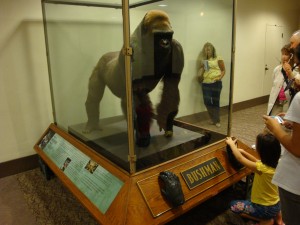 This museum was originally called the Columbian Museum of Chicago, and it served to house many of the exhibitions and artifacts from the World’s Fair Columbian Exposition, which was held in Chicago in 1893 to mark the 400th anniversary of Columbus’ arrival in the New World. Later, the name was changed to its present form in honor of its first major benefactor, Marshall Field. The Field Museum has a number of popular displays: “Sue,” the most complete and best-preserved Tyrannosaurus Rex fossil thus far discovered; “Bushman,” a stuffed gorilla that originally lived in Chicago’s Lincoln Park Zoo and was renowned for his temper; the collection of mummies in the Museum’s “Inside Ancient Egypt” exhibition; and the numerous dinosaur skeletons in the exhibit “Evolving Planet.” Other permanent exhibits include the Grainger Hall of Gems, the Underground Adventure, the Ancient Americas, and Dioramas, as well as several working laboratories: the DNA Discovery Center, McDonald’s Fossil Prep Lab, and the Regenstein Laboratory.
This museum was originally called the Columbian Museum of Chicago, and it served to house many of the exhibitions and artifacts from the World’s Fair Columbian Exposition, which was held in Chicago in 1893 to mark the 400th anniversary of Columbus’ arrival in the New World. Later, the name was changed to its present form in honor of its first major benefactor, Marshall Field. The Field Museum has a number of popular displays: “Sue,” the most complete and best-preserved Tyrannosaurus Rex fossil thus far discovered; “Bushman,” a stuffed gorilla that originally lived in Chicago’s Lincoln Park Zoo and was renowned for his temper; the collection of mummies in the Museum’s “Inside Ancient Egypt” exhibition; and the numerous dinosaur skeletons in the exhibit “Evolving Planet.” Other permanent exhibits include the Grainger Hall of Gems, the Underground Adventure, the Ancient Americas, and Dioramas, as well as several working laboratories: the DNA Discovery Center, McDonald’s Fossil Prep Lab, and the Regenstein Laboratory.
The John G. Shedd Aquarium
This museum dates back to 1930, and at one time was the largest indoor aquarium in the world, with 19 million liters of water. It was also the first inland aquarium with a permanent saltwater fish collection. There are over 25 thousand fish in the aquarium, but there are other species as well, including marine mammals, birds, snakes, amphibians, and insects. The Museum has five permanent exhibits: Amazon Rising, Caribbean Reef, Waters of the World, the Oceanarium, and Wild Reef. The Shedd Aquarium is more popular than the Field Museum, with over 2 million visitors annually.
The Adler Planetarium & Astronomy Museum
Built on what used to be an artificial island in Lake Michigan, this museum also dates back to 1930. It was the first planetarium in the Western Hemisphere, and it is the oldest planetarium in existence today. Numerous astronomical artifacts are on display, including a telescope made by William Herschel, and an astrolabe dating back to 12th century Baghdad. Permanent exhibits include Our Solar System, Planet Explorers, Shoot for the Moon, Astronomy in Culture, Telescopes: Through the Looking Glass, Space Visualization Lab, as well as three full-size theaters.
The Museum of Science and Industry
 Located near the University of Chicago, this museum first opened in 1933 during Chicago’s “Century of Progress Exhibition.” It is the largest science museum in the Western Hemisphere, and it ranks third among Chicago’s cultural attractions. Some of its popular exhibits include a working coal mine, the U-505 (a German submarine captured during World War II), a large (330 square meters) model railroad, the Pioneer Zephyr (the first diesel-powered streamlined stainless steel passenger train), and the Apollo 8 spacecraft. Other favorites include Colleen Moore’s model Fairy Castle, a Foucault pendulum, the incubator for hatching chicks, the prenatal development display of human fetuses ranging from 28 days to full term (38 weeks), and even cross-sectional slices of human cadavers. At Christmastime, the Museum hosts a “Christmas Around the World” exhibit.
Located near the University of Chicago, this museum first opened in 1933 during Chicago’s “Century of Progress Exhibition.” It is the largest science museum in the Western Hemisphere, and it ranks third among Chicago’s cultural attractions. Some of its popular exhibits include a working coal mine, the U-505 (a German submarine captured during World War II), a large (330 square meters) model railroad, the Pioneer Zephyr (the first diesel-powered streamlined stainless steel passenger train), and the Apollo 8 spacecraft. Other favorites include Colleen Moore’s model Fairy Castle, a Foucault pendulum, the incubator for hatching chicks, the prenatal development display of human fetuses ranging from 28 days to full term (38 weeks), and even cross-sectional slices of human cadavers. At Christmastime, the Museum hosts a “Christmas Around the World” exhibit.
Writing Assignment: At the Museum
Vocabulary
ticket
admission
reciprocal admission
discount / free day
group rate
membership
season pass
model
display
interactive display
stuffed animal
exhibit
traveling exhibit
guided tour
self-guided tour
line
wing
curator
guard
field trip
souvenir
re-entry stamp
children’s museum / hands-on/discovery museum
validate parking
flash prohibited
1. Where is this picture taken?
2. What do you see in the picture?
3. How many displays are there in the great hall?
4. What type of museum do you think this is?
5. What other types of museums are there?
6. What can you see at a museum?
7. What else might you see in a museum besides the exhibits?
8. What kind of exhibits are in a museum only for a short time before they are sent to another museum?
9. What kinds of people usually visit a museum?
10. What is a school trip to a museum called?
11. How can you get to the museum?
12. What can you do with your car while you are at the museum?
13. What do you often need to get inside the museum?
14. What kind of special deals are often available for admission?
15. If you leave the museum but want to come back the same day, how can you get back in?
16. How can you find your way around the museum?
17. What are the different parts of the museum called?
18. Who works at a museum?
19. Can you take pictures in a museum?
20. What kinds of displays do they have at a children’s museum?
Paragraph: A Visit to the Museum
Have you ever been to a museum? What kinds of museum are available where you live? Which museum is your favorite? Write a paragraph about a museum that you’ve visited.
Grammar Basics: Unit 26 – What are you doing tomorrow? (Solutions)
Exercises: Complete the following sentences using either the present continuous or the simple present.
Example:
What (you / go) to do on your day off? ==> What are you going to do on your day off?
1. Get to bed early – tomorrow we’re leaving at 6 in the morning.
2. I’m so tired, I’m going to go home and go straight to bed.
3. The bus comes every 15 minutes, so it’s fairly convenient.
4. Mary has to stay home – the plumber is coming this afternoon to fix the toilet.
5. The engaged couple is planning a June wedding.
6. When does the next train leave?
7. I’m taking TOEFL this summer so I can attend university in the fall.
8. John is working every day next week.
9. I thought he said the concert starts at 7:30.
10. Susan’s baking a cake for Tom’s surprise party tomorrow.
Grammar Basics: Unit 26 – What are you doing tomorrow?
As we have already seen, the present continuous (am / is / are + V-ing) is used for something that is happening now. However, we can also use it for some future events as well:
Examples:
I’m going to the mountains on my vacation next summer.
He’s taking a test tomorrow.
She’s singing a solo in the concert next weekend.
Similarly, we can use the present continuous to indicate that we have decided to do something, or have arranged to do something:
Examples:
Can you come to our house next weekend? We’re having a party.
Are you running in the marathon this fall?
I broke my foot this summer, so I’m not going to run.
What are you doing this Friday?
I’m going to go see a movie.
In particular, “am / is / are going to V something”:
We’re going to have a baby.
Do not use the simple present for plans or arrangements. However, when talking about schedules, simple present is okay:
Examples:
What time does your class start?
It starts at 8 a.m. every day!
The train leaves the station at exactly 7:15.
Please don’t be late – the movie starts at 1:45.
Exercises: Complete the following sentences using either the present continuous or the simple present.
Example:
What (you / go) to do on your day off? ==> What are you going to do on your day off?
1. Get to bed early – tomorrow we (leave) at 6 in the morning.
2. I’m so tired, I (go) to go home and go straight to bed.
3. The bus (come) every 15 minutes, so it’s fairly convenient.
4. Mary has to stay home – the plumber (come) this afternoon to fix the toilet.
5. The engaged couple (plan) a June wedding.
6. When (the next train / leave)?
7. I (take) TOEFL this summer so I can attend university in the fall.
8. John (work) every day next week.
9. I thought he said the concert (start) at 7:30.
10. Susan (bake) a cake for Tom’s surprise party tomorrow.
Culture focus: St. Patrick’s Day
 Saturday, March 17, is St. Patrick’s Day. You may have heard of it, but perhaps you’re wondering what sort of holiday it is. Let’s take a quick look at this informal holiday, which has come to be viewed largely as a day of Irish national pride.
Saturday, March 17, is St. Patrick’s Day. You may have heard of it, but perhaps you’re wondering what sort of holiday it is. Let’s take a quick look at this informal holiday, which has come to be viewed largely as a day of Irish national pride.
St. Patrick’s Day is a celebration commemorating Saint Patrick, the patron of Ireland. It started as a feast day, but then in the 1600s it officially became a Catholic “holy day” (from which we get the English word “holiday”) of obligation for Roman Catholics in Ireland. Patrick was a fourth century slave from Britain who was brought to Ireland. He eventually escaped and returned to his family, but came back later to Ireland and was involved in Christianizing the Irish people. According to legend, he drove the snakes from Ireland, but this is rather unlikely, since the Ireland’s climate is not hospitable to snakes in the first place. This legend could be interpreted symbolically, however: evil (represented by the snakes) was driven from Ireland through St. Patrick’s evangelism. Legend also states that he used a shamrock (three-leaved clover) to explain the Christian doctrine of the Trinity. It is for these reasons that Saint Patrick has been closely associated with Ireland and the Irish people.
Many Irish people immigrated to the United States, especially in the 1800s and early 1900s. These immigrants brought with them their Irish pride, and St. Patrick’s Day evolved from a religious celebration to a day of national pride, making Irish-American largely responsible for creating our modern St. Patrick’s Day celebration. Today, there are several ideas that people associate with St. Patrick’s Day:
Wearing of the green – Not only are shamrocks green, but Ireland is known as the “Emerald Isle,” so it is not surprising that the color green should be prominently displayed or worn on St. Patrick’s Day. Although the phrase “wearing of the green” refers specifically to wearing a shamrock on one’s lapel, by extension, people wear some sort of green item.
 Leprechauns – These mythical little creatures are said to guard the pot of gold that is supposed to be at the end of the rainbow. If you can catch a leprechaun, you can make him take you to his secret stash of treasure. But watch out – he will try to trick you and sneak away without giving you the gold!
Leprechauns – These mythical little creatures are said to guard the pot of gold that is supposed to be at the end of the rainbow. If you can catch a leprechaun, you can make him take you to his secret stash of treasure. But watch out – he will try to trick you and sneak away without giving you the gold!
Parades – People love a parade, and St. Patrick’s Day is no different. Cities with a large Irish population, such as Boston and Chicago, are well known for their St. Patrick’s Day parades. It seems that politicians especially love these parades, as it gives them exposure to potential voters and free publicity 🙂 .
Drinking – For whatever reason, drinking is a stereotype associated with Irish people, and many people like to imbibe in Irish beer. In keeping with the spirit of the holiday, some bars will offer beer that has been dyed green. Fortunately, the color does not affect the flavor.
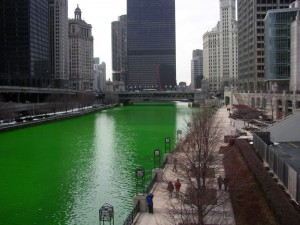 Greening of the Chicago River – Since 1962, there has been a tradition of dyeing the Chicago River green in honor of St. Patrick’s Day. Chicago has a notable Irish population; indeed, there have been no fewer than 12 Irish mayors in the city’s history. The idea for coloring the river green came from a certain dye that plumbers used to detect if any waste materials from the sewer system were leaking into the river. The precise formula used for the dye is “top secret.” Some people were concerned that it might be harmful to the environment, but water samples with the dye were sent to an environmental engineer as well as a professor at Johns Hopkins University, both of whom confirmed that the dye was safe to use.
Greening of the Chicago River – Since 1962, there has been a tradition of dyeing the Chicago River green in honor of St. Patrick’s Day. Chicago has a notable Irish population; indeed, there have been no fewer than 12 Irish mayors in the city’s history. The idea for coloring the river green came from a certain dye that plumbers used to detect if any waste materials from the sewer system were leaking into the river. The precise formula used for the dye is “top secret.” Some people were concerned that it might be harmful to the environment, but water samples with the dye were sent to an environmental engineer as well as a professor at Johns Hopkins University, both of whom confirmed that the dye was safe to use.
Grammar Basics: Unit 25 – Regular and Irregular Verbs (Solutions)
Exercises: Complete the sentences. Choose an appropriate verb from the list and put it in its correct form.
Example:
The trees (sway) in the wind. ==> The trees swayed in the wind.
1. The children played nicely together while the babysitter was watching them.
2. Have you ever seen a real live lion before?
3. We can’t watch the movie tonight – all the tickets are sold out.
4. Several large branches have broken off our tree because of the strong wind.
5. Dave left the cage door open, and now the bird has flown out.
6. How long have you known Dr. Brock?
7. Tim spoke with me the other night and told me that he had gotten engaged!
8. The children haven’t made their beds yet.
9. The pitcher threw a fast ball, and struck out the batter.
10. Mike has eaten all his vegetables, so he’ll get a special treat for dessert.
Grammar Basics: Unit 25 – Regular and Irregular Verbs
Regular Verbs
For regular verbs, the simple past and the past participle is –ed:
wash ==> washed
paint ==> painted
whistle ==> whistled
bake ==> baked
snow ==> snowed
rain ==> rained
If a verb ends in a syllable with a short vowel sound and the final consonant is one letter, that letter is doubled:
tap ==> tapped
stop ==> stopped
pat ==> patted
drip ==> dripped
For verbs that end in a consonant followed by a y, the y is changed to i before adding the –ed:
study ==> studied
tidy ==> tidied
try ==> tried
Irregular Verbs
Irregular verbs do not follow this –ed pattern. They are exceptions, and must be memorized.
Sometimes, the simple past and the past participle of irregular verbs is the same:
make ==> made, made
find ==> found, found
buy ==> bought, bought
cut ==> cut, cut
think ==> thought
Sometimes, however, the simple past and the past participle are different:
write ==> wrote, written
break ==> broke, broken
eat ==> ate, eaten
sing ==> sang, sung
Here is a list of the 50 most common English irregular verbs:
say (said, said)
make (made, made)
go (went, gone)
take (took, taken)
come (came, come)
see (saw, seen)
know (knew, known)
get (got, got/gotten (US))
give (gave, given)
find (found, found)
think (thought, thought)
tell (told, told)
become (became, become)
show (showed, shown / showed)
leave (left, left)
feel (felt, felt)
put (put, put)
bring (brought, brought)
begin (began, begun)
keep (kept, kept)
hold (held, held)
write (wrote, written)
stand (stood, stood)
hear (heard, heard)
let (let, let)
mean (meant, meant)
set (set, set)
meet (met, met)
run (ran, run)
pay (paid, paid)
sit (sat, sat)
speak (spoke, spoken)
lie (lay, lain)
lead (led, led)
read (read, read)
grow (grew, grown)
lose (lost, lost)
fall (fell, fallen)
send (sent, sent)
build (built, built)
understand (understood, understood)
draw (drew, drawn)
break (broke, broken)
spend (spent, spent)
cut (cut, cut)
rise (rose, risen)
drive (drove, driven)
buy (bought, bought)
wear (wore, worn)
choose (chose, chosen)
Exercises: Complete the sentences. Choose an appropriate verb from the list and put it in its correct form.
Example:
The trees (sway) in the wind. ==> The trees swayed in the wind.
break
eat
fly
know
leave
make
play
see
sell
speak
strike
tell
throw
watch
1. The children __________ nicely together while the babysitter was watching them.
2. Have you ever __________ a real live lion before?
3. We can’t __________ the movie tonight – all the tickets are __________ out.
4. Several large branches have __________ off our tree because of the strong wind.
5. Dave __________ the cage door open, and now the bird has __________ out.
6. How long have you __________ Dr. Brock?
7. Tim __________ with me the other night and __________ me that he had gotten engaged!
8. The children haven’t __________ their beds yet.
9. The pitcher __________ a fast ball, and __________ out the batter.
10. Mike has __________ all his vegetables, so he’ll get a special treat for dessert.


